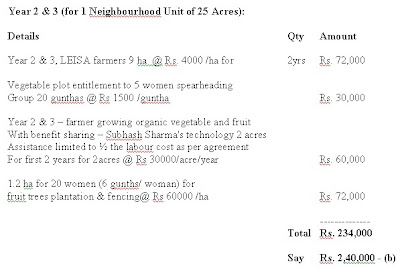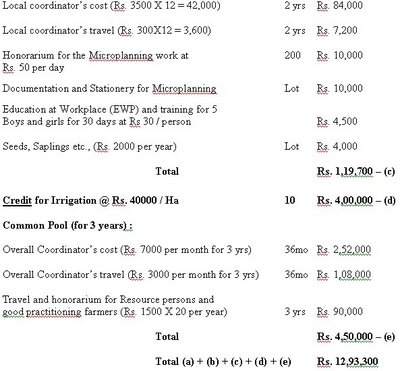This section is divided into 2 parts
What next at Magadi?
What next overall in terms of expanding this to other places?
What next at Magadi?
Our experimental plots have caught the attention of the local farmer community in MGHalli. Having witnessed the higher productivity and other advantages of Renke’s method of soil preparation, about 21 farmers have come forward to adapt this method in their farms on atleast 1 gunta land to start with (out of their own resources). The idea now is to verify the Microplanning data as well and then move towards forming a collective.
All the necessary institutional arrangements have to be tried out and put in place to evolve a replicable and scalable institutional structure for the initiative to go on. We had been toying with the idea of forming a local co-operative with all the stakeholders themselves being part of it to take care of the various MOUs etc., But this angle is still being worked out and the final work is not yet heard
Meanwhile, one Ms. Aparna, Bangalore, has shown interest in marketing these fully organic vegetables. She has already started and has been buying the vegetables produced from our plots (on a weekly basis, once in a week right now) and has been giving reasonable prices to the growers. If Ravi and his team can organize varieties, quantity and timing of the crops to give a continuous supply to suit the demand, it can generate a modest income to the workers on the field.
In order to try out mainstreaming we have already started talking to the Panchayats to allocate us the food-for-work component of the program from Javahar Rozgar Yojana or any other for further expansion to the other plots in MG Halli. Recently Ravi (and Prasanna) has approached the local village Panchayat seeking financial support from them to expand the process in the village. The panchayat members have shown interest, have even visited the experimental plots. A video screening of the intervention was done at the Panchayat General Body Meeting. After the screening the Panchayat by voice vote passed a resolution to take this up in the action plan for coming financial year of 2006-2007. Further processes are on
Ravi and Prasanna have also been talking to the women’s self help groups and some interested youth in the village.
Unfortunately, a similar spreading into the village neighbourhood has not happened at Thorepalya. The other proposed agenda of involving youth or school children in our activities there by training them on scientific methods of sustainable farming has not been very successful either. Frequent absenting of the chosen children made the valuable time of volunteers of our team visiting all the way from Bangalore not justifiable. Also, since the nature of activity was such that could not be well programmed time-wise, instead was more dependent on the crop growth stages, it was difficult to engage the children on a continuous basis to retain their interest or participation.
Also efforts would be to consolidate now and repeat the results to establish consistency in the results so that we have something more concrete to take forward.
What next overall in terms of expanding this to other places?
The Chinatamani Development
Meanwhile there has been one more encouraging development. We had presented this program of ours to the Chitamani MLA Dr. Sudhakar Reddy, a very progressive MLA. We discussed about this program and then we were taken to a neighbouring village of Chintamani called as kaavalugaanahalli. In this village we had a preliminary discussion. From this discussion the following positive things have emerged
a) A farmer by name Srinivas has come forward to offer his plot for the start of the work there
b) There seems to be reasonable irrigation sources which could be explored
c) The local panchayat has agreed to support the 'Food-for-Work' component of the program. In fact in a subsequent meeting 2-3 more Ward members of the Gram Panchayat were present and they also wanted to take it to their villages
d) But only thing lacking there is the social process as there is not even a Self-Help Group in that village and we are now thinking of sending Ravi from Motaganahalli for about 2 days a week to do some handholding till the time a local social process is started
Some of the steps as of now thought of for Kolar is
i) Initial 20 Guntha plot with 5 women
ii) We could also start the Sharma model for the rest of the 2 ½ acres of the 3 acre plot identified
iii) We could also initiate the bio-energy plantations in the common lands
iv) Saving in the irrigation cost recovery to be shown as a pilot to the MLA
The Other places
We have initiated dialogue with some of the Community Based Organisations (CBO's) in districts which have NREGA already there. Districts like Raichur and Anantpur (Timbaktu) where there is already some struggles by these organisations to make NREGA work. So as a Value addition to these processes and as a natural next step to this struggle we have been suggesting this initiative to be taken up by them. Most of the social instruments are in place at these places like SHG's, Organic farming expertise etc., There have been some positive feedback by them. We need to evolve some concrete steps now for the same
At the same time I have a 6 acre plot in Maralagondala near Magadi where I would want to replicate Sharma model and similarly Vatsala has about 6 acres of land on Kanakapura Road. We are waiting for the core team to evolve and then we would have to raise funds for the same to be able to take up this work there.
The Evolution of a Core Team to take this forward
We are increasingly moving towards formation of a core team of members who would take this initiative forward. So in that direction we have started identifying the various resource people who have been part of the efforts off and on. We had one preliminary meeting of all such people and discussed in detail of the various components involved and also the possible people who could be involved (mentioned in the brackets)
a) A triangular Arrangement has to be made between the Leasing company ( AID or similar organizations), farmers and the landless
b) 4 kinds of Management has to be done
i) Food security and Livelihood
ii) Bio Energy ( Largely Perennials)
iii) Fodder Management ( with minimal intervention)
iv) Commercial crops
c) Ecosystem potential assessment (quick water availability assessment) to inform the Gram Sabha (NU). This has to be done with the help of hydrological data etc., (Mr. Srinivas Badiger)
d) Entitlements, Min. water entitlement, allocations and rights of Produce to be presented to the NU and other social instruments like the Self Help Groups, Panchayats etc.,(Prasanna)
e) Irrigation structures. Augmentation and efficiency of the irrigation per se (Vatsala alongwith a group of technicians typically diploma holders or from CWC etc., )
f) Organic Crop Management – Livestock, Green cover, fertility, grasslands, poultry etc., (Satish, Krishna Prasad and other friends of Sahaja Samruddha)
g) Energy and Artisanship (Srinath Shastry and CWC alongwith a core technician team which will get trained at the Technical Center put up by Datye at Karjat near Mumbai. There is an 8 acre plot of one of the friends of Datye and he has offered to give his land for this training center.
h) Technical Backup to replicate Sharma and other techniques reg soil / water nutrients (Top rate team by Datye)
i) One person yet to be identified who is good in the SHG formation and also can pick up the Agri techniques to coordinate all the plots at Karnataka level. This person is increasingly becoming crucial for us as this person would be the only person who would be completely full time with no conflicting priorities and would be thinking, eating, sleeping about this initiative


 Please note the following:
Please note the following: